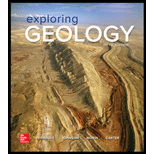
The main sedimentary environments on land along with some characteristics of each.
Answer to Problem 1BYL
Terrestrial, fluvial, deltaic, lacustrine, and glacial settings are the principal sedimentary environments on land.
Explanation of Solution
The terrestrial sedimentary environments can include mountainous regions and desert regions. Steep slopes developed on the bedrock are typical for a mountain setting. Several mountains, except some, own a higher elevation. Steep slopes and high elevation enhance the erosional activity as a result of which a huge quantity of sediments (of various sizes) is produced. The so-formed sediments would later be carried out of the mountains into some other enviroments.
The desert environment where arid or semi-arid climates prevail is another terrestrial sedimentary setting. Wind is the active geologic agent in such regions with a dry climate. The wind takes up and carries the sand and finer particles along with it and deposits them when it loses its carrying capacity and energy. The deposited sediments would take the form of sand dunes that are entirely made up of sand and loess.
The fluvial environment comprises streams as the main agents. The streams in the mountains characteristically possess steep gradients and are confined by the bedrock canyons. The streams usually become braided as they leave the mountains, which is evident from the multitude of channels that riven and rejoin. A stream brings a lot of sediments along its way to the ocean and deposits at places wherever its velocity, capacity, and competence reduce or wherever it encounters with some barriers.
The streams that run over a gentle landscape usually meander elegantly. A majority of streams are bordered by fairly flat lands called floodplains that would be covered during flooding events. The floodwaters carry sand and mud, which may be deposited layer upon layer that results in the formation of floodplains of the meandering streams.
As the stream enters a standing water body such as a lake or ocean, its velocity decreases and currents slow down, which leads to the spreading out and deposition of much of the transported sediments. The sediment heaps up at the mouth of the stream and develops into a delta that stretches into the ocean or lake.
The lacustrine environment is concerned with lakes. Lakes include a variety of environments that range from quiet, deep water found in the center to more dynamic water along with waves driven by winds along the shoreline. The beaches found along the shoreline could be rocky or sandy. Certain lakes may be permanently filled with water; however, others get dried up entirely due to the eveporation of water or seepage of water into the underlying materials.
The highly saturated soil, commonly found in very wet environments, such as those nearby lakes or delta regions, paves the way for the development of lakes, swamps, marshlands, and ponds. These type of wetlands characteristically possess profuse water- dependent vegetation, which could be a significant component of the sediment. The underlying sediment would be protected from the atmosphere by the water, which controls the amount of oxidation.
The high mountains and higher latitude or polar regions will have thick accumulations of snow with an accumulation rate greater than the rate at which snow gets removed through melting or other processes. As time passes, the snow turns out to be even more compacted into ice, which would move downhill as a glacier . When glaciers move, the underlying materials are eroded and carried along with them. The eroded sediment and water might be released when the ice melts, mostly at the terminus of the glacier.
Want to see more full solutions like this?
Chapter 7 Solutions
Exploring Geology
 Applications and Investigations in Earth Science ...Earth ScienceISBN:9780134746241Author:Edward J. Tarbuck, Frederick K. Lutgens, Dennis G. TasaPublisher:PEARSON
Applications and Investigations in Earth Science ...Earth ScienceISBN:9780134746241Author:Edward J. Tarbuck, Frederick K. Lutgens, Dennis G. TasaPublisher:PEARSON Exercises for Weather & Climate (9th Edition)Earth ScienceISBN:9780134041360Author:Greg CarbonePublisher:PEARSON
Exercises for Weather & Climate (9th Edition)Earth ScienceISBN:9780134041360Author:Greg CarbonePublisher:PEARSON Environmental ScienceEarth ScienceISBN:9781260153125Author:William P Cunningham Prof., Mary Ann Cunningham ProfessorPublisher:McGraw-Hill Education
Environmental ScienceEarth ScienceISBN:9781260153125Author:William P Cunningham Prof., Mary Ann Cunningham ProfessorPublisher:McGraw-Hill Education Earth Science (15th Edition)Earth ScienceISBN:9780134543536Author:Edward J. Tarbuck, Frederick K. Lutgens, Dennis G. TasaPublisher:PEARSON
Earth Science (15th Edition)Earth ScienceISBN:9780134543536Author:Edward J. Tarbuck, Frederick K. Lutgens, Dennis G. TasaPublisher:PEARSON Environmental Science (MindTap Course List)Earth ScienceISBN:9781337569613Author:G. Tyler Miller, Scott SpoolmanPublisher:Cengage Learning
Environmental Science (MindTap Course List)Earth ScienceISBN:9781337569613Author:G. Tyler Miller, Scott SpoolmanPublisher:Cengage Learning Physical GeologyEarth ScienceISBN:9781259916823Author:Plummer, Charles C., CARLSON, Diane H., Hammersley, LisaPublisher:Mcgraw-hill Education,
Physical GeologyEarth ScienceISBN:9781259916823Author:Plummer, Charles C., CARLSON, Diane H., Hammersley, LisaPublisher:Mcgraw-hill Education,





